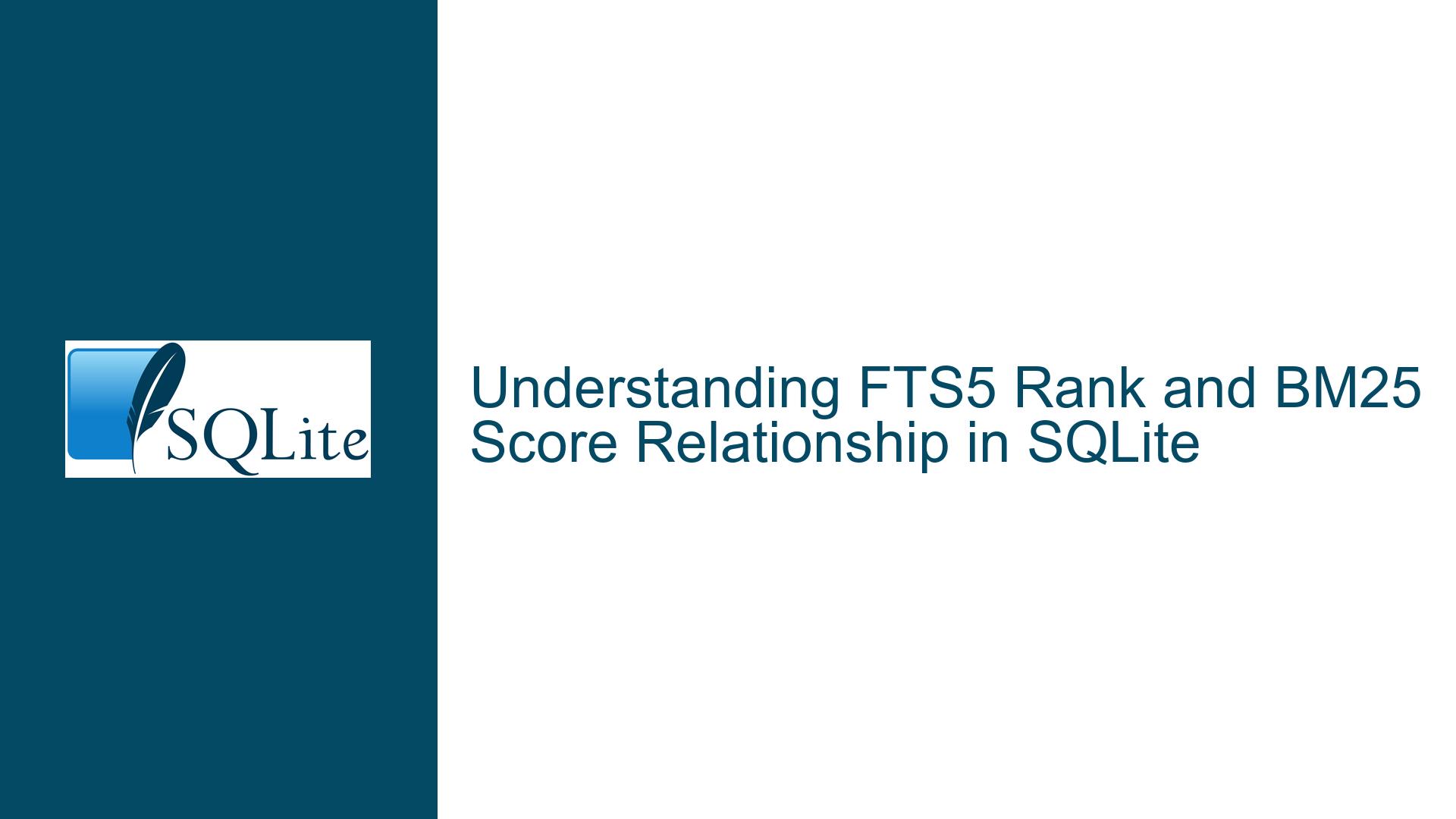FTS5 Rank and BM25 Score Relationship in SQLite
Issue Overview: Misalignment Between FTS5 Rank and BM25 Scores
When working with SQLite’s Full-Text Search (FTS5) extension, users often encounter confusion regarding the relationship between the rank column and the bm25() function. The rank column is a built-in feature of FTS5 that provides a relevance score for search results, while the bm25() function calculates a relevance score based on the BM25 algorithm, a probabilistic information retrieval model. The core issue arises when users attempt to sort search results using ORDER BY rank but observe that the results do not align with the bm25() scores, leading to questions about how these two metrics are related and how they should be used.
The confusion is compounded by the fact that both rank and bm25() are used to determine the relevance of search results, but they operate under different assumptions and calculations. The rank column is a simpler, more heuristic-based approach, while bm25() is a more sophisticated algorithm that takes into account term frequency, inverse document frequency, and document length normalization. This discrepancy can lead to unexpected results, especially when users assume that sorting by rank will yield the same order as sorting by bm25().
Possible Causes: Why FTS5 Rank and BM25 Scores May Diverge
The divergence between rank and bm25() scores can be attributed to several factors. First, the rank column in FTS5 is calculated using a simpler algorithm that may not account for all the nuances of document relevance. It is designed to provide a quick and efficient way to rank search results, but it may not always align with the more complex BM25 algorithm. The rank column is typically based on term frequency and proximity, but it does not incorporate inverse document frequency or document length normalization, which are key components of the BM25 algorithm.
Second, the bm25() function in FTS5 is a more sophisticated tool that calculates relevance scores based on the BM25 algorithm. This algorithm considers not only the frequency of terms within a document but also the frequency of terms across the entire corpus (inverse document frequency) and the length of the document. This means that bm25() can provide a more accurate measure of relevance, especially in cases where document length or term distribution across the corpus plays a significant role in determining relevance.
Third, the configuration of the FTS5 table can also impact the relationship between rank and bm25(). For example, the presence of certain tokenizers or custom ranking functions can alter how rank is calculated, leading to discrepancies when compared to bm25(). Additionally, the version of SQLite and the specific implementation of FTS5 can influence how these scores are computed, as different versions may have different default settings or optimizations.
Finally, user error or misunderstanding can also contribute to the issue. For instance, users may inadvertently use ORDER BY rank when they intended to use ORDER BY bm25(), leading to unexpected results. Additionally, users may not be aware of the differences between rank and bm25(), leading to confusion when the two metrics do not align.
Troubleshooting Steps, Solutions & Fixes: Aligning FTS5 Rank and BM25 Scores
To address the issue of misalignment between FTS5 rank and bm25() scores, users can take several steps to ensure that their search results are sorted according to the desired relevance metric. The first step is to understand the differences between rank and bm25() and determine which metric is more appropriate for their specific use case. If the goal is to achieve a more accurate measure of relevance, especially in cases where document length or term distribution across the corpus is important, then bm25() is likely the better choice.
Once the appropriate relevance metric has been determined, users should ensure that they are using the correct syntax in their SQL queries. For example, if the goal is to sort search results by bm25() scores, the query should explicitly use ORDER BY bm25(fts_table) rather than ORDER BY rank. This will ensure that the results are sorted according to the BM25 algorithm, which may provide a more accurate measure of relevance.
In cases where users still encounter discrepancies between rank and bm25(), it may be necessary to examine the configuration of the FTS5 table. Users should check the tokenizer settings, custom ranking functions, and other configuration options to ensure that they are not inadvertently altering the calculation of rank. Additionally, users should verify that they are using the correct version of SQLite and that the FTS5 extension is properly enabled.
If the issue persists, users can consider creating a minimal reproducible example that demonstrates the problem. This can help isolate the issue and make it easier to diagnose. For example, users can create a small FTS5 table with a few sample documents and run a series of queries to compare the results of ORDER BY rank and ORDER BY bm25(). This can help identify any patterns or anomalies that may be contributing to the issue.
Finally, users should consult the SQLite documentation and community forums for additional guidance. The SQLite documentation provides detailed information on the FTS5 extension, including the rank column and the bm25() function. Additionally, the SQLite community forums are a valuable resource for troubleshooting and advice, as they provide a platform for users to share their experiences and solutions.
In conclusion, the relationship between FTS5 rank and bm25() scores can be complex, but with a clear understanding of the differences between these metrics and careful attention to query syntax and table configuration, users can ensure that their search results are sorted according to the desired relevance metric. By following the troubleshooting steps outlined above, users can resolve issues related to the misalignment of rank and bm25() scores and achieve more accurate and relevant search results in their SQLite databases.






